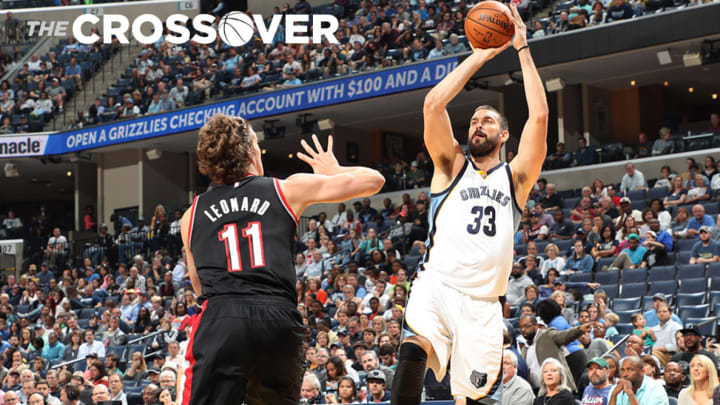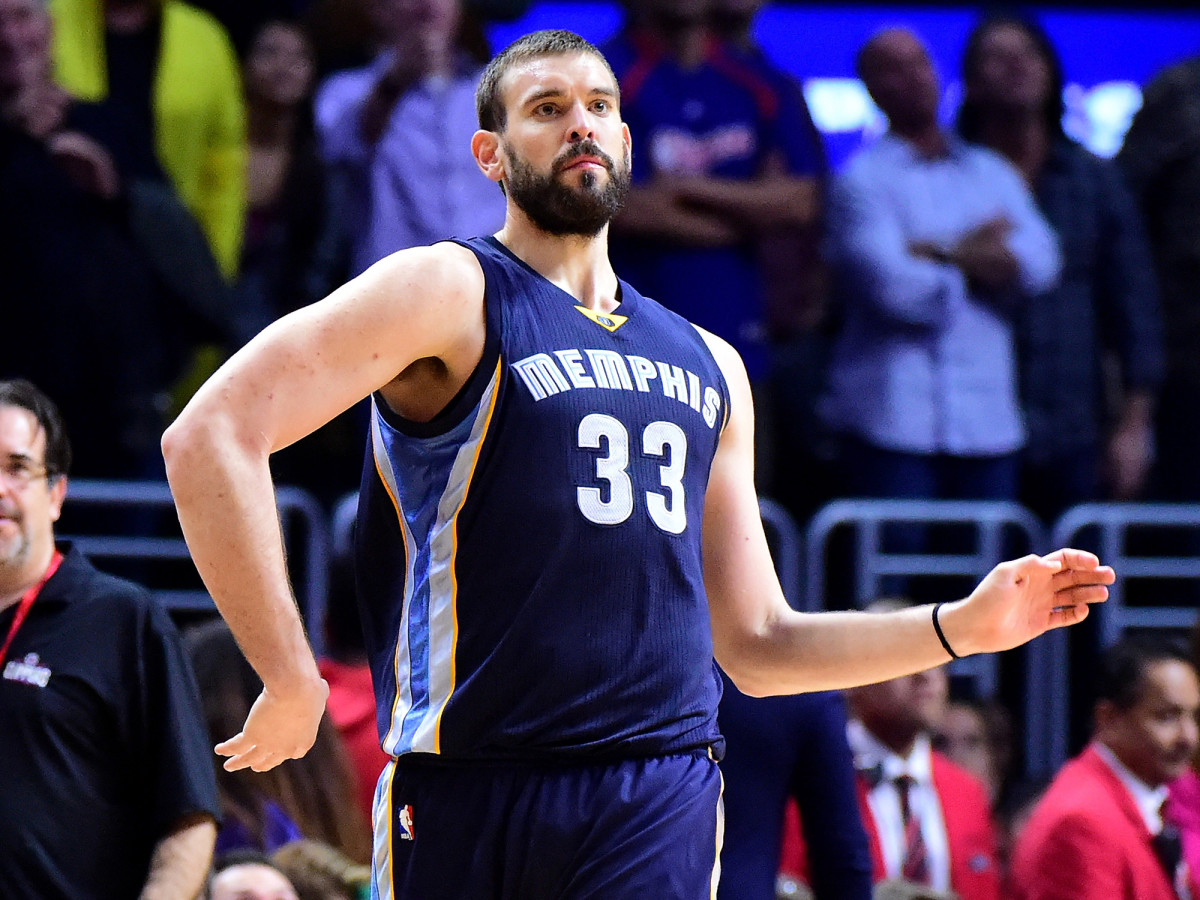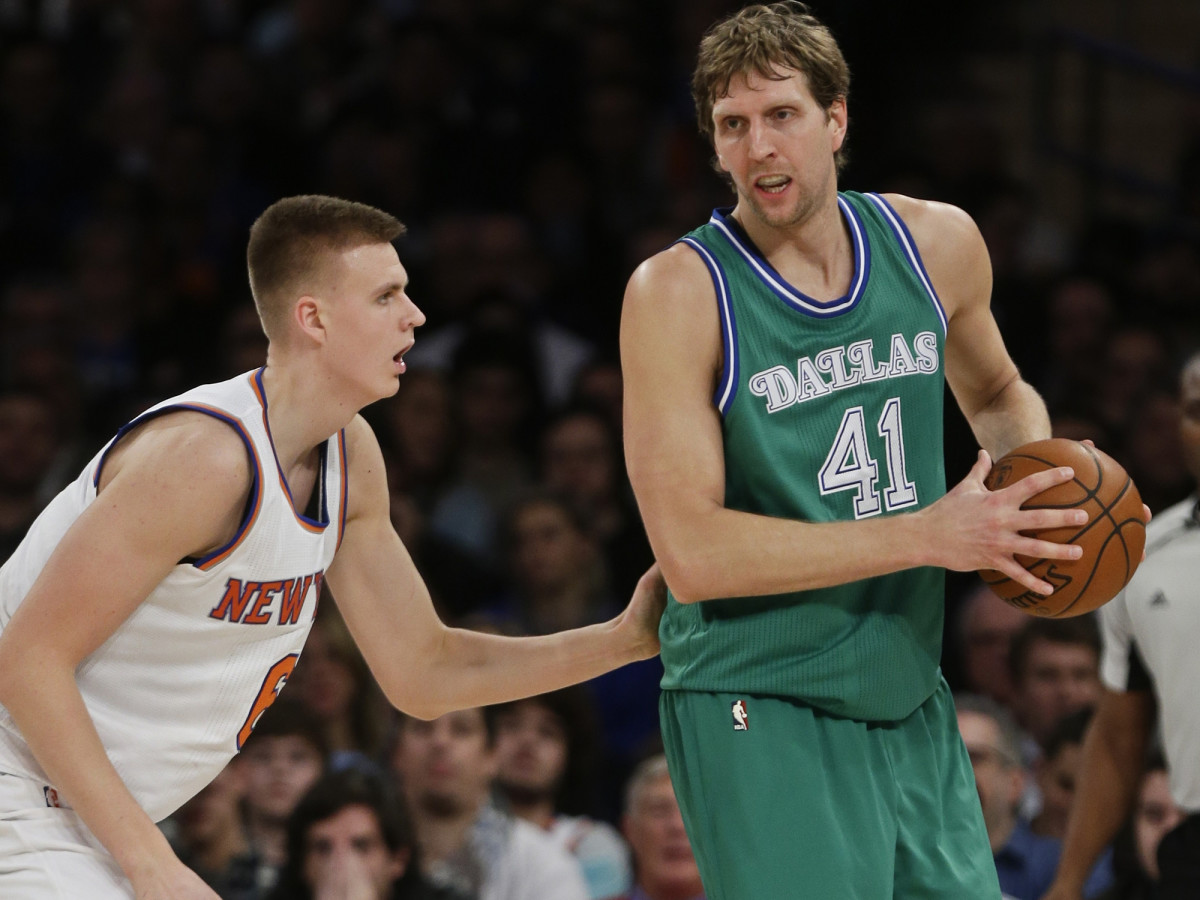Inside The NBA's Next Big Three-Point Renaissance

As the ball ripped through the net, Marc Gasol began to dance. Or was it more of a strut? He wiggled his arms as if he was performing the Bernie, puffing his chest and jutting his jaw as the Staples Center scoreboard announced the Grizzlies' 111–107 win over the Clippers. Gasol’s game-sealing, left corner three-pointer snapped the Clippers’ seven-game winning streak. Imitating MMA superstar Conor McGregor’s signature walk was more than appropriate for Gasol.
“I apologize… to absolutely nobody,” Gasol tweeted the morning after his game-winning splash.
The game-clincher was Gasol’s fourth triple on the evening, two more than he converted for the entire 2015–16 season. Through his first 13 games this year, the 7'1" center has attempted 45 shots from beyond the three-point line, just 16 shy of his eight-year career total prior to this current campaign.
The big Spaniard is far from alone. Prior to this year, only nine 7-foot centers had ever attempted more than 100 three-pointers in a single season, according to basketball-reference: Arvydas Sabonis, Wang Zhizhi, Andrea Bargnani, Spencer Hawes, Byron Mullens, Meyers Leonard, Donatas Motiejunas, Frank Kaminsky and Kristaps Porzingis. A previously unthinkable nine 7-foot centers are on pace to easily eclipse 100 total three-point attempts this season alone: Hawes, Leonard, Porzingis and Kaminsky once again, as well as five newcomers in Gasol, Brook Lopez, Justin Hamilton, Karl-Anthony Towns and Joel Embiid. A 10th, Gasol’s older brother, Pau, is on the cusp of joining the rare ranks of gigantic sharpshooters, too.
As perimeter creativity, length and athleticism permeated the NBA, the basketball community incorrectly concluded the center position was growing obsolete. The parameters of the position were merely evolving. A premium of shooting and versatility didn’t terminate the position—as the league’s 2012 All-Star ballot change suggested—it merely sparked an adaptation to the modern confines of NBA offense.

Leonard turned to the long-range shot as a matter of survival. The Trailblazer’s frontcourt rotation already featured four mainstays, as Robin Lopez, Chris Kaman and Joel Freeland complemented LaMarcus Aldridge during Leonard’s fateful third NBA season in 2014–15. “Essentially, I fell behind in the rotation, so I had to find a way to expand my game,” Leonard told SI.com. Portland’s coaching staff and front office previously identified Leonard’s mid-range shooting ability during his career at Illinois. His already fluid shooting mechanics converted 5-of-15 attempts between 17 feet and the three-point line during his final collegiate season, per Synergy Sports.
Then-Blazers assistant coach Kim Hughes began molding Leonard into just the seventh 7-foot center to hoist 100 single-season three-point attempts in NBA history. Under Hughes’s instruction, Leonard lofted three after three for 30 minutes to an hour before and after each Blazers practice. The project even continued during team off days. “Initially, it was all kind of spot up, space the floor,” Leonard explained. “And now it’s pick and pops, playing on different actions, so it’s just become a good weapon for me.”
Portland publicly debuted its experiment on Dec. 22 of that season, as Leonard launched seven three pointers in 31 minutes while starting in the place of an ill Aldridge. He averaged 2.0 three-points attempts throughout the rest of the 2014–15 campaign—connecting on 42.0% of his 112 tries—and drained 10 of his 13 three-point looks during the Blazers’ five-game, first-round playoffs loss to the Memphis Grizzlies.
Give Thanks: Wiggins, Parker And Embiid Deliver Hefty Returns On 2014 NBA Draft
Following Aldridge’s departure for San Antonio during that subsequent off-season, Leonard’s floor spacing became an integral facet of Portland’s offensive identity. “If you’re playing him as a center, usually the other team’s center is guarding him out on the perimeter, which opens things up,” head coach Terry Stotts said. “It affects how you guard players, especially in pick and roll situations, transition threes, we have to respect it. We can’t view it as just an anomaly and so we have to close the space and not just concede those threes.”
Stotts first witnessed the gravitational pull a 7-foot three-point shooter can induce upon opposing defenses as an assistant coach with the Dallas Mavericks. Dirk Nowitzki revolutionized the power forward position—disqualifying him from this study of long-range-bombing 7-foot centers—by stretching opposing defenses until they snapped. “Manute Bol was shooting threes,” said Mavericks owner Mark Cuban. “Dirk, I think he deserves credit for defining what a stretch-4 can do.”
The Mavericks drafted 7-foot center A.J. Hammons out of Purdue with the 46th overall pick in this past June’s draft. His individual workouts incorporate a slew of three-point looks from around the arc. “A lot of these guys are very skilled and if it’s something that they can do, why not let ‘em do it, because five-men generally get open for long shots,” said Mavericks coach Rick Carlisle. “If a flick of the wrist can get you three points and grinding in the post against two or three helpers can only get you two, you do the math.”
Nowitzki exchanged cell phone numbers with Porzingis last fall, inviting the young Latvian to dinner and a training session in Dallas during a future summer. Scheduling conflicts prevented the epic collaboration this past off-season, although Nowitzki hopes to hand down his knowledge in 2017.
“What kind of helped me was, around the time I came in, the league sort of changed the rules and then went away from the 18-second backdowns and they put the zone in and they put the hand-checking rule in,” Nowitzki said. “So I think some of the rule changes really played into my game and that helped me flourish.”

Minnesota head coach Tom Thibodeau has re-engineered the Timberwolves’ offensive attack by taking advantage of the rule changes Nowitzki alluded to. By eliminating hand-checking, the NBA has sequentially created a premium on opening floor space for aggressive moves towards the rim, by stretching opposing defenses to the outer limits of the hardwood.
The Wolves have chucked 23.7 threes per game during the first 13 contests of Thibodeau’s inaugural season in Minnesota, a sizeable uptick from the 16.4 triples per night the team attempted a year ago under Sam Mitchell. Towns is hoisting 3.9 three-pointers per contest of his own. “We’ve been working tremendously hard this off-season,” said Towns, the reigning Rookie of the Year. Thibodeau told SI.com Minnesota will make the 6'11" Gorgui Dieng—already an 18-foot jumper savant—migrating to the three-point line an off-season priority.
“It opens up your cutting game,” Thibodeau explained. “I think anytime guys that can shoot, where the defense has to play away from the basket, now you can start cutting to the basket because the lane’s not clogged up with bigs. I think that puts a lot more pressure on the defense.”
The same experiment is being conducted in Philadelphia, where Sixers rookie center Joel Embiid is already badgering opposing defenses from the perimeter this season. After sprouting to 7'2" during his two years of rehab, the runaway Rookie of the Year favorite ranks second in league (50%) in three-point percentage among players who have attempted more than 20 shots from beyond the arc, per NBA.com. “If they leave me open, I’m going to shoot it,” Embiid told reporters after converting all four of his three-point attempts in a Nov. 5 game against the Cavaliers. When he’s not confidently rising up and connecting from distance, the 22-year-old Embiid has used an array of ball fakes and hesitation dribbles to befuddle defenders as well, previewing the next stage of the modern center’s evolution.
“He has an unusual skill as a five-man that we have to use from time to time,” Philadelphia head coach Brett Brown said that evening. “That balance of what he can do is the holy grail.”
Joel Embiid: 'I'm The Process'
Nets rookie head coach Kenny Atkinson initially oversaw the 6'10" Al Horford’s progression to the perimeter during his four years as a Hawks assistant. Now that he's in a leadership role, Atkinson has given the green light to his team’s two 7-foot centers, Brook Lopez and Justin Hamilton, to tee off from deep. “I think a good offense, you’re taking what the defense gives you,” Atkinson explained. “So, if they’re popping and they’re open, they have the freedom to shoot it. But I think it’s part of basketball today, it’s part of the NBA. We embrace it.”
Lopez and Hamilton have even shared the floor together for 25 minutes this season. The Nets’ offense has converted 44% of its three-point tries during that span. “I feel I’ve always been able to do it, it’s just the staff and my teammates have confidence in me doing it,” Lopez told SI.com. “The situation presented itself in that way and we just looked to take advantage of it.”
Devin Booker Q&A: 'I Think It's Going To Come Together With Time'
For those that watched closely, it was obvious Lopez could step beyond the arc. “You could see it when he was warming up. He could shoot no problem,” said Hawks shooting coach Ben Sullivan. The three-point specialist behemoths of today all exhibited smooth shooting mechanics and a foundation for perimeter success in years prior. Modernized basketball theology has simply now rendered a previously insane concept as commonplace.
Sullivan told SI.com that 90 percent of shooting the three is just practice. The remaining 10 percent? Constructing a strong base below the waist, not necessarily a leaping jump often affiliated with premier wing sharpshooters. “Jump height doesn’t have as much to do with generating power as it does using your legs to transfer the force from the ground all the way up through your release, ” Sullivan said.
The league’s 30 teams are once again on pace to set a new NBA record for three-point attempts per game this season, continuing the yearly trend that emerged following the 2011 lockout. It was only a matter of time before the game’s tallest participants joined the party. And we won’t hear any apologies for their tardiness.
